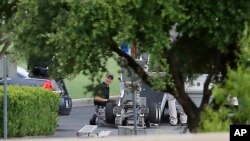The Dallas Police Department’s use of a robot to kill a sniper who fatally shot five police officers is apparently the first time U.S. police used a robot to apply lethal force, and it is raising ethical concerns and questions about their future use by local law enforcement agencies.
After negotiations failed on July 7, Dallas police used a remote-controlled robot to deliver an explosive device that killed Micah Johnson, an Army veteran who served in Afghanistan. Johnson killed five police and wounded nine others in a sniper attack as a protest against recent police shootings was ending.
The incident is raising concerns about the increased use of robots in policing, including how and when to deploy them without endangering the lives of innocent bystanders and who should be held accountable if something goes wrong.
“This was not an ethical dilemma for me. I’d do it again to save our officers lives,” Dallas Police Department Chief David Brown told reporters on Monday.
But Brown emphasized his department will not change its approach to policing. “We are committed to community policing. In the 21st century, it is the best way to police our country,” Brown said.
The robot was not designed to deliver explosives, but rather to handle defensive tasks such as disarming explosive devices.
Out of harm's way
Endeavor Robotics, a Bedford, Massachusetts-based robotics manufacturer, has sold more than 6,000 robots to police and military operations worldwide.
“Using a robot this way was, I think, an appropriate use of the technology given the extreme circumstances,” said CEO Sean Bielat in an interview with VOA.
“I don’t think there’s anything that’s inherently more ethically troubling about using a robot to tele-operate from a distance than there is using another method that can be used from a distance, for instance a sniper. In both cases, you’re keeping an individual out of harm’s way to take on a dangerous and lethal person,” added Bielat, a major in the U.S. Marine Corps Reserves.
But others, such as Noel Sharkey, a robotics expert and co-founder of the International Committee for Robot Arms Control, told VOA he has reservations about the use of robots by local police.
“It can be argued that this is justifiable given the dangerous events in Dallas with a police killer. And it appears to be legal, but it is a very dangerous precedent to set. It could make it easier to do the next time and easier again in subsequent uses, until it becomes a new norm of policing.”
Use spreading
Sharkey cited the Midwestern state of North Dakota as an example of the adoption of robot technologies in policing. Last year North Dakota became the first U.S. state to legalize police use of armed drones.
The original intent of the bill was for police to use drones to look for evidence after search warrants had been obtained. But the final version passed into law permits police to arm the drones with “less than lethal” weapons such as rubber bullets, tasers and tear gas.
“The Dallas event changed the nature of policing and could spread to crowd control and the suppression of protest. We need a much wider public discussion and debate about this and more legal constraints to limit use,” Sharkey said.
Sharkey also noted there is the “real danger” of hackers seizing control of police robots and turning them against citizens or the authorities.
“The genie is out of the bottle. Pandora’s let out all the sins,” said Donald Mazzella, a board member of the National Robotics Education Foundation.
While Mazzella supports limited and non-lethal use of robots in policing, he is concerned about the development and police deployment of “more independent” robots.
“It is the next step. It’s a step that’s been expected,” he told VOA.
Robots currently being deployed are of the remote-controlled variety. And a growing number of the country’s estimated 15,000 police departments have robots in their arsenals.
Endeavor Robotics’ Bielat said his company has sold robots similar to the one used in Dallas to “a couple hundred” police departments, including the Massachusetts State Police and the Boston Police Department.
“As the price of technology continues to decline, I think you will see more and more police departments take [them] up,” Bielat said.









